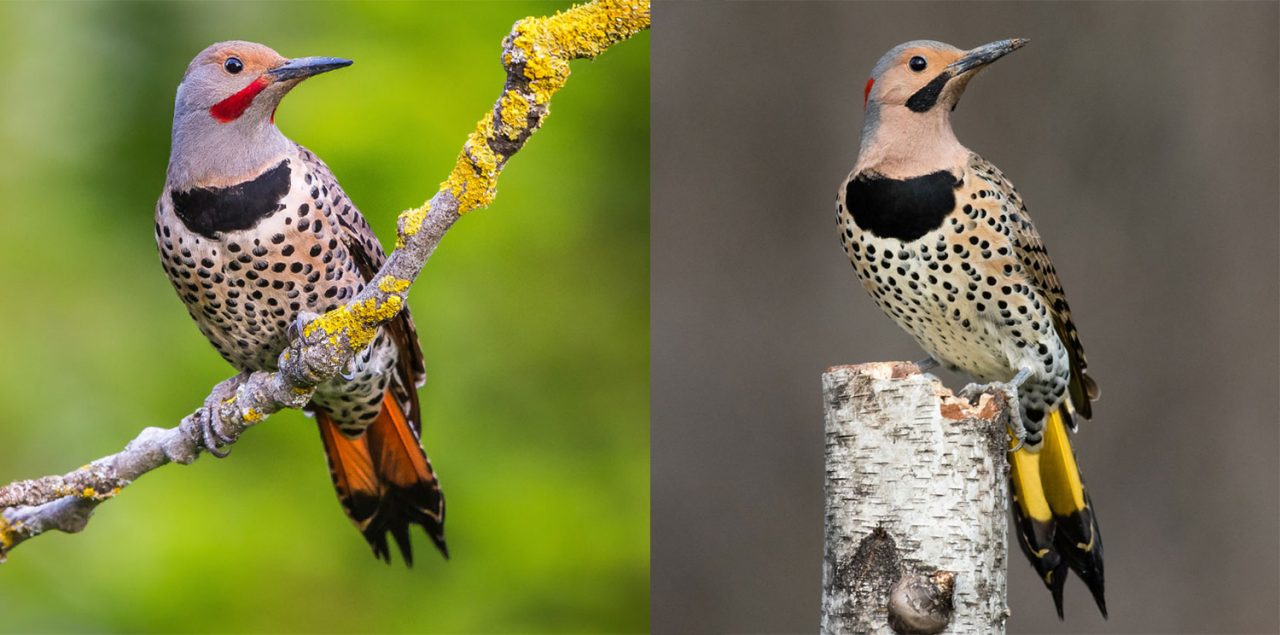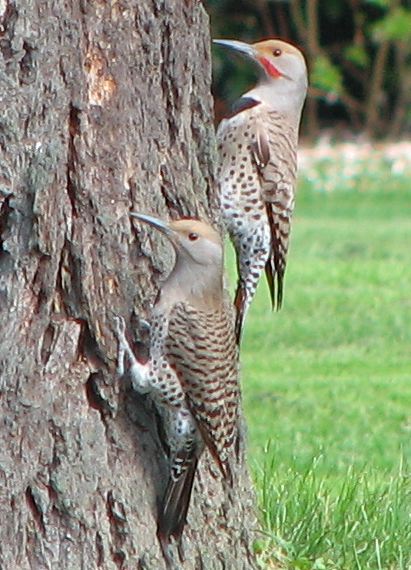
Two kinds of Northern Flicker: “Red-shafted” of western North America by Todd Steckel; “Yellow-shafted” of eastern North America by Bill McMullen, via Birdshare.
Flickers: The Closer You Look, The Less Different They Are
By Hugh Powell
June 6, 2018
For
birders, one of the many small delights of traveling cross-country is
that moment when the flickers change. These pretty and common
woodpeckers flash bright colors in their wings and tail—salmon-red in
western North America and lemon-yellow in the East.
It’s
such a noticeable difference that for decades the two were regarded as
separate species, Red-shafted and Yellow-shafted Flickers. But in 1982,
the two forms were officially lumped and considered a single species,
the Northern Flicker.
In
the years since, scientists have wondered whether a closer look at the
two birds’ genomes might reveal differences too small to have been
detected with earlier technology. Now, a new study published this week in Auk: Ornithological Advances, by Stepfanie Aguillon and colleagues at the Cornell Lab of Ornithology, presents an answer.
The
original studies of the 1980s compared the flickers’ DNA using protein
molecules as a proxy, and they were unable to discover any differences
between the two forms at all.
In the new study, Aguillon and her
collaborators directly compared more than 16,000 DNA locations, and for
the first time found clear evidence of genetic differences between
Red-shafted and Yellow-shafted forms. At the same time, those
differences were very small, indicating that the two lineages diverged
only recently.
As with Blue-winged and Golden-winged Warblers, the flickers are an example of two forms that physically look very different but genetically are nearly identical.
“I
find Northern Flickers to be really interesting because up until this
point, we couldn’t find any differences at all, even though the two
forms look so different.” Aguillon says. “Now that we have these
results, it seems likely that only a few small parts of their genomes
differ—the ones that are related to their plumage differences.”
But
by the same token, Aguillon says, those small differences shouldn’t be
interpreted as confirmation that the two forms are a single species.
That decision would be better answered through studies of ecology,
mating behavior, and hybridization than by a simple tabulation of
genetic differences, she says.
Nevertheless,
the study showcases today’s exquisitely sensitive genetic sequencing
tools—enabling Aguillon to see the slightest of differences between two
close relatives, and to begin to reconstruct the evolutionary pathways
that brought them into being.
Source: https://www.allaboutbirds.org/flickers-the-closer-you-look-the-less-different-they-are/?platform=hootsuite

female on left, male on right




The Alabama State Bird
Northern Flicker
Nominated for Canada National Bird
Woodpeckers and Hummingbirds
Northern flicker (Colaptes auratus)
This showy, medium woodpecker can be seen in Canada from Yukon to Newfoundland, often favouring the ground in woodlands and forest edges near open habitats, yards and parks.
They have barred brown upperparts and pale spotted underparts, with a black bib on their upper breast.
In the east, northern flickers have bright yellow feathers on the undersides of their wings and tails; in the west, these feathers are red.
Vote for Northern flicker in Canada's National Bird Project. ... Northern flicker (
There are more than 450 species of birds across Canada, but until now, not one of them has been designated as our national bird. In 2015, the team at Canadian Geographic decided it was time to change that, and founded the National Bird Project with the aim of declaring an official bird for Canada by 2017, the 150th anniversary of Confederation.

American Ornithology @AmOrnith

Cornell Lab @CornellBirds



The Alabama State Bird
Northern Flicker
Nominated for Canada National Bird
Woodpeckers and Hummingbirds
Northern flicker (Colaptes auratus)
This showy, medium woodpecker can be seen in Canada from Yukon to Newfoundland, often favouring the ground in woodlands and forest edges near open habitats, yards and parks.
They have barred brown upperparts and pale spotted underparts, with a black bib on their upper breast.
In the east, northern flickers have bright yellow feathers on the undersides of their wings and tails; in the west, these feathers are red.
Northern flicker - National Bird Project - Canadian Geographic
nationalbird.canadiangeographic.ca/bird.asp?name=Northern-flicker&id=1054
Welcome to the National Bird Project
Thank you for your help determining Canada's national bird!
Join the adventure and subscribe to Canadian Geographic
There are more than 450 species of birds across Canada, but until now, not one of them has been designated as our national bird. In 2015, the team at Canadian Geographic decided it was time to change that, and founded the National Bird Project with the aim of declaring an official bird for Canada by 2017, the 150th anniversary of Confederation.
CANADA'S NATIONAL BIRD
American Ornithology @AmOrnith
Official AOS Press Release:
Name change of Gray Jay back to the original common name of Canada Jay

Cornell Lab @CornellBirds
What kind of flicker do you have near you?
The red-shafted and yellow-shafted forms were once considered different species—
but new research clarifies just how similar they are: http://ow.ly/A0bb30ku9wY
Why do Northern flickers peck on metal?
Behavior - Woodpeckers peck into trees in search of food or to create a nesting site.
They also "drum," or peck in a rapid rhythmic succession to establish their territory and attract mates. Drumming usually occurs in the spring on metal or wood resonant surfaces.Apr 16, 2014
No comments:
Post a Comment